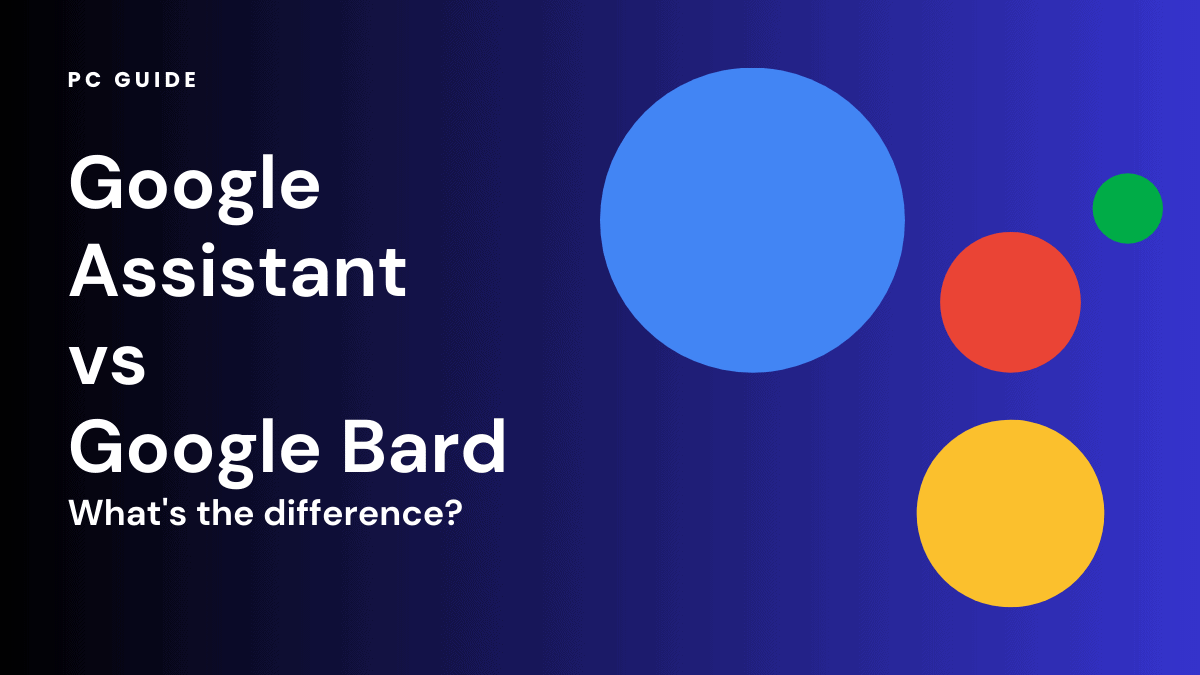Google Assistant vs Google Bard – What’s the Difference?

Table of Contents
Google Assistant and Google Bard are both conversation AI systems developed by Google. But are there any key differences in the capabilities of the two pieces of software? Let’s find out!
AI-powered conversational models have taken the world by storm. One such fantastic technology is Google Assistant, which has been around since 2016.
Prime Day may have closed its doors, but that hasn't stopped great deals from landing on the web's biggest online retailer. Here are all the best last chance savings from this year's Prime event.
- Sapphire Pulse AMD Radeon™ RX 9070 XT Was $779 Now $719
- AMD Ryzen 7 7800X3D Processor Was $449 Now $341
- Skytech King 95 Ryzen 7 9800X3D gaming PC Was $2,899 Now $2,599
- LG 77-Inch Class OLED C5 TV Was $3,696 Now $2,996
- AOC Laptop Computer 16GB RAM 512GB SSD Was $360.99 Now $306.84
- Lexar 2TB NM1090 w/HeatSink SSD Was $281.97 Now $214.98
- Apple Watch Series 10 GPS+ Smartwatch Was $499.99 Now $379.99
- AMD Ryzen 9 5950X processor Was $3199.99 Now $279.99
- Garmin vívoactive 5 Smartwatch Was $299.99 Now $190
*Prices and savings subject to change. Click through to get the current prices.
Moreover, Google recently unveiled its generative AI model, Bard, in May 2023. While Bard and Google Assistant may be similar in some aspects, the former is more sophisticated and powerful than the latter.
Keep reading to learn more about the differences between Google Bard and Google Assistant.
What is Google Assistant? Google’s Answer to Virtual Assistance
Google Assistant, Google’s answer to similar technology like Apple’s Siri and Amazon’s Alexa, is a virtual assistant that uses natural language processing and machine learning to conduct searches, set reminders and timers, control smart home devices, and have rudimentary conversations. Its interactions are designed for precision and efficiency, providing up-to-date information and following instructions with creativity.
Features and Capabilities of Google Assistant
- Practical Tasks and Interactions: Complete practical tasks like setting reminders, controlling smart devices, and playing media using voice commands. Google Assistant’s interactions are tailored to users’ queries, offering a seamless experience.
- Concise Information and Precision: Responses are concise information pulled from Google’s database, ensuring accuracy and up-to-date information.
- Integration with Google Services: Provide direct access to Google services, including the search engine, maps, YouTube, Google Lens, and Google Workspace.
- Limited Conversational Abilities: While offering a search generative experience, conversational abilities are limited to simple question-answering on a fixed range of topics.
Google Assistant in Daily Life
Google Assistant’s integration with various platforms and devices, including Android, iOS, and Google Nest speakers and displays, makes it a versatile tool for daily use. Whether you need assistance with writing through Google Docs or exploring new features in Google Workspace, Google Assistant is there to help, provided you have internet access.
The Evolution of Google Assistant
Google Assistant continues to evolve, offering new features and enhancing its creativity in responding to users’ queries. While it may not have the advanced conversational abilities of some newer technologies, its precision in handling practical tasks and integration with various Google services makes it a valuable tool for many users.
What is Google Bard? A New Era of Conversational AI
With the increasing competition in the development of artificial intelligence from companies such as OpenAI and Microsoft, Google has responded by launching its own generative AI chatbot called Bard. This large language model (LLM) represents a significant advancement in dialogue applications and conversational AI.
Advanced Language Capabilities and Integration
Unlike the Google virtual assistant technology, Bard incorporates more advanced language capabilities, a broader knowledge pattern, and new technologies. It’s designed to handle complex topics with accuracy, utilizing extensive datasets to provide real-time responses. Furthermore, while Google Assistant gives direct access to Google search, maps, and media playback, Bard synthesizes information and provides unique responses like humans.
Distinct Capabilities of Google Bard
- Conversational and Generative AI Model: Bard is more than just a chat tool; it’s a conversation and generative AI model with wider usage and applications such as writing, coding, research, and more.
- Human-like Interaction: It aims to have more free-flowing, open-ended conversations, mimicking the human brain, and can engage in chat on various topics.
- Advanced Natural Language Techniques: Bard uses more advanced natural language AI techniques, including ranking potential responses, to ensure the date of information is accurate and relevant.
- Intended as an AI Companion: Unlike traditional utility tools, Bard is intended as an AI companion, offering integration with various platforms and providing personalized prompts.
Google Bard vs. Google Assistant
While both Google Bard and Google Assistant fall under the umbrella of Google AI, their applications and functionalities differ significantly. Google Assistant focuses on utility, providing search results and direct access to maps and media. In contrast, Bard emphasizes conversational AI, offering a more engaging experience with real-time responses.
- Google Assistant: Primarily a utility tool, offering direct access to search results, maps, and media playback.
- Google Bard: A conversational AI model, utilizing GPT-4 and ChatGPT Plus technologies, designed for more free-flowing dialogue and complex queries.
The Future of Google AI
Google Bard represents a significant step forward in the field of conversational AI. Its integration with various platforms, ability to handle complex queries, and focus on providing human-like interaction sets it apart from traditional tools like Google Assistant. Whether you’re looking for a virtual companion to assist with research or a tool to engage in meaningful dialogue, Bard offers a unique and engaging experience that’s sure to shape the future of Google AI.
Conclusion
Google Assistant is mainly for accessing Google’s services through AI. On the other hand, Bard aims for more human-like conversational abilities and extensive response generations. Hence, Google Bard is more powerful than Google Assistant.
